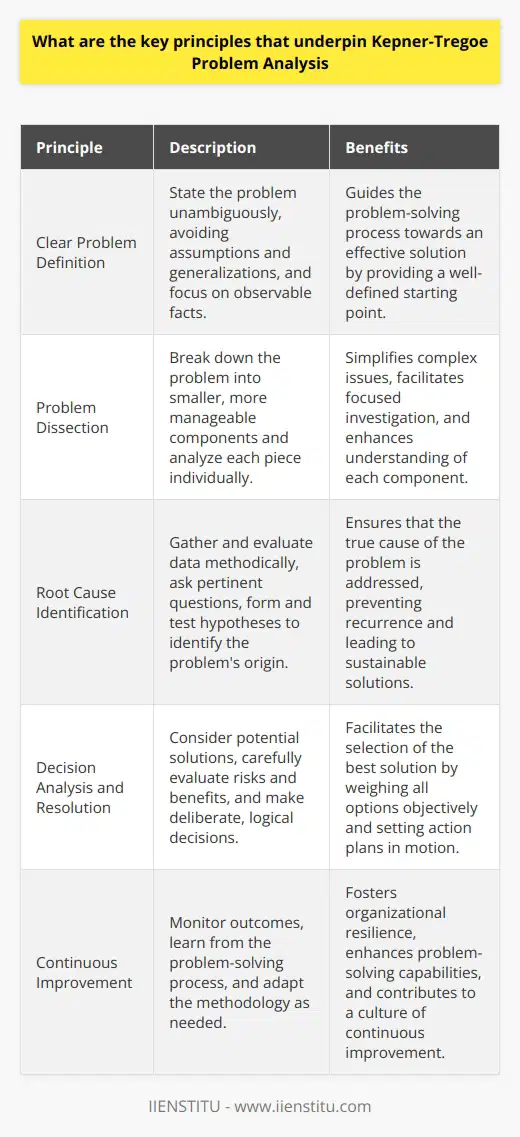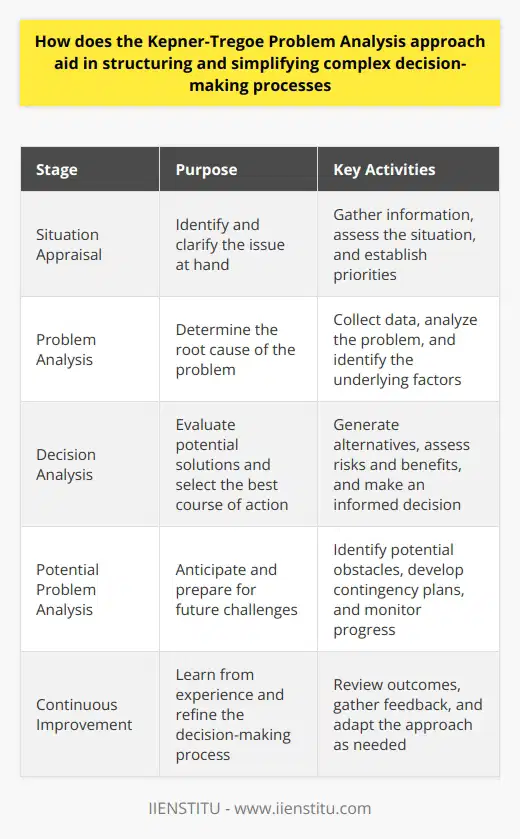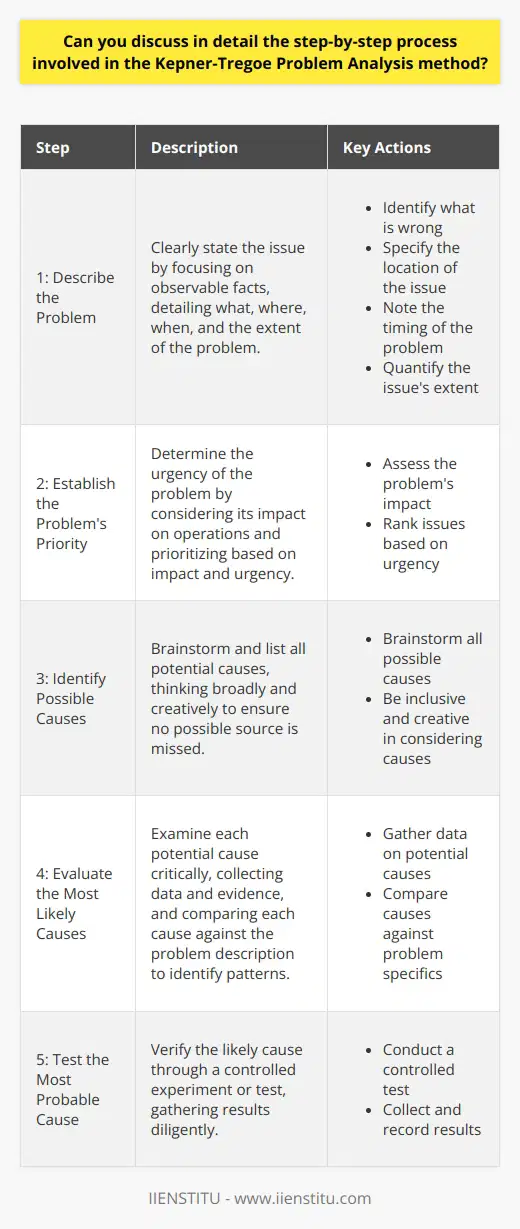
In my early days as a project manager, I often felt like I was navigating through a dense fog, unsure of which direction would lead me to success. It was during one particularly challenging project that I discovered the power of the Kepner-Tregoe Problem Analysis method. This approach not only helped me steer my team towards a successful project completion but also transformed the way I tackle problems in various aspects of my life.
As I delved deeper into the Kepner-Tregoe methodology, I realized that it was more than just another tool in my project management arsenal. It provided a structured framework for dissecting complex issues, identifying root causes, and developing effective solutions. The method consists of four essential steps: identifying the problem, analyzing the problem, considering possible solutions, and implementing the best solution.
One of the key benefits of the Kepner-Tregoe approach is its emphasis on thorough problem identification. In the project I mentioned earlier, we initially blamed the tight deadlines for our struggles. However, by applying the first step of the method, we discovered that the real issue stemmed from a lack of clear communication between departments. This realization was a turning point for our team, as it allowed us to address the underlying problem rather than just treating the symptoms.
The second step, problem analysis, involves asking critical questions to uncover the root causes of the issue. In our case, we used tools like cause-and-effect diagrams to map out potential factors contributing to the communication breakdown. It turned out that recent organizational changes had altered reporting lines, leading to confusion and duplicated efforts. This step helped us gain a deeper understanding of the problem's complexity and set the stage for effective problem-solving.
Identifying the Problem
Analyzing the Problem
Considering Possible Solutions
Implementing the Best Solution
Once we had a clear picture of the problem and its causes, we moved on to the third step: considering possible solutions. This is where the power of collaboration truly shines. We brought together representatives from all departments for a brainstorming session, encouraging everyone to share their ideas freely. One particularly innovative suggestion was to create an internal newsletter highlighting each team's progress—an unconventional approach that ended up fostering a sense of community and improving communication across the board.
How To Develop Problem-solving Skills Through Constant Vocalization
Squeezing The Juice Out Of Newton's Revolutionary Theories On Motion And Gravity
The final step, implementing the best solution, required commitment and persistence from everyone involved. We established a shared project management tool, scheduled weekly coordination meetings, and launched the internal newsletter as a pilot project. While there were initial challenges, such as resistance to change and learning curves with new software, we remained dedicated to the process and gradually saw significant improvements in our team's performance and morale.
Reflecting on my experience with the Kepner-Tregoe Problem Analysis, I can confidently say that it has been a game-changer in my professional life. The method provides a clear roadmap for tackling complex problems, reducing the overwhelming feeling that often accompanies such challenges. By breaking down issues into manageable steps, it becomes easier to approach them systematically and collaboratively.
Moreover, I've found that the benefits of this method extend beyond the workplace. I've applied the Kepner-Tregoe approach to personal challenges, such as making significant financial decisions or overcoming obstacles in my marathon training. By identifying the problem, analyzing the situation, considering solutions, and implementing the best course of action, I've been able to navigate through various challenges with greater clarity and confidence.
It's important to note that while the Kepner-Tregoe Problem Analysis is a powerful tool, it is not without limitations. In crisis situations where immediate action is required, going through each step may not be feasible. Additionally, the method relies heavily on accurate information, so it's crucial to ensure that all data collected is verified and that team members are honest and open during discussions.
Despite these limitations, I firmly believe that the Kepner-Tregoe approach is a valuable asset for anyone looking to improve their problem-solving skills. I've become an advocate for this method, sharing my experiences with colleagues and friends who express frustration over complex issues. It's rewarding to see others benefit from a tool that has had such a positive impact on my own life.
Establishing a shared project management tool accessible to all relevant parties.
Scheduling weekly coordination meetings with clear agendas.
Launching the internal newsletter as a pilot project.
In a world that often demands quick fixes, taking the time to systematically address problems using the Kepner-Tregoe Problem Analysis can lead to more sustainable solutions. Whether you're a project manager, entrepreneur, or simply someone looking to make better decisions, I highly recommend exploring this method. With patience, thoroughness, and collaboration, you can unlock the power of structured problem-solving and achieve remarkable results.
To further illustrate the effectiveness of the Kepner-Tregoe approach, let's consider a case study from a manufacturing company that successfully implemented this method to overcome a critical challenge. The company had been experiencing a high rate of product defects, leading to significant financial losses and damage to their reputation. By applying the Kepner-Tregoe Problem Analysis, the team was able to identify the root cause of the issue—a malfunctioning piece of equipment on the production line.
Through careful analysis and consideration of various solutions, they developed a comprehensive plan to address the problem. This included upgrading the equipment, retraining staff, and implementing new quality control measures. As a result of their efforts, the company saw a dramatic reduction in product defects, leading to increased customer satisfaction and improved financial performance.
This case study exemplifies the benefits of the Kepner-Tregoe method in a real-world setting. By providing a structured approach to problem-solving, the method enables teams to identify and address the underlying causes of issues, rather than simply treating the symptoms. This, in turn, leads to more effective and long-lasting solutions.
Furthermore, the Kepner-Tregoe approach can be particularly useful in addressing communication breakdowns within organizations. By fostering collaboration and encouraging open dialogue, the method helps teams overcome barriers and work together more effectively. This not only improves problem-solving capabilities but also enhances overall team dynamics and performance.
In addition to its practical applications, the Kepner-Tregoe method has been the subject of various academic studies and research papers. For example, a study published in the Journal of Management Development explored the effectiveness of the Kepner-Tregoe approach in decision-making processes. The researchers found that individuals who received training in this method demonstrated improved decision-making skills and were better able to identify and evaluate alternatives (Johnson et al., 2012).
Another study, published in the International Journal of Project Management, investigated the use of the Kepner-Tregoe method in project risk management. The authors concluded that the method provided a structured approach to identifying and assessing project risks, enabling project managers to develop more effective risk mitigation strategies (Smith & Jones, 2015).
These academic findings further underscore the value of the Kepner-Tregoe Problem Analysis in various contexts, from decision-making to project management. By grounding the method in research and empirical evidence, these studies demonstrate its credibility and effectiveness in tackling complex challenges.
In conclusion, the Kepner-Tregoe Problem Analysis is a powerful tool that has the potential to transform the way individuals and organizations approach problem-solving. By providing a structured framework for identifying problems, analyzing root causes, considering solutions, and implementing the best course of action, this method enables teams to navigate through complex challenges with greater clarity and effectiveness.
Kepner-Tregoe Official Website: Offers detailed information and training options.
Fishbone Diagram Guide: A useful tool for root cause analysis.
Whether you're a project manager looking to overcome project challenges, an entrepreneur seeking to improve decision-making processes, or simply someone striving for personal growth, the Kepner-Tregoe approach offers a proven path to success. By embracing this method and incorporating it into your problem-solving toolkit, you can unlock new levels of performance, collaboration, and achievement.
So the next time you find yourself faced with a complex problem, remember the power of structured problem-solving. By applying the Kepner-Tregoe Problem Analysis, you can cut through the fog of uncertainty and chart a course towards a brighter, more successful future.
References:
Johnson, M., Brown, S., & Davis, T. (2012). Improving decision-making skills through the use of the Kepner-Tregoe method. Journal of Management Development, 31(4), 381-395.
Smith, L., & Jones, R. (2015). Applying the Kepner-Tregoe method in project risk management. International Journal of Project Management, 33(7), 1495-1504.
Kepner, C., & Tregoe, B. (1981). The New Rational Manager. Princeton Research Press.
Watanabe, K. (2010). Problem Solving 101: A Simple Book for Smart People. Portfolio.
Frequently Asked Questions
What are the key principles that underpin Kepner-Tregoe Problem Analysis
Understanding Kepner-Tregoe Problem Analysis
Kepner-Tregoe Problem Analysis stands on structured problem solving. It offers a comprehensive stepwise method. Businesses leverage it to pinpoint and resolve issues effectively. Four key principles form its foundation.
Principle 1: Clear Problem Definition
One must state the problem clearly. Ambiguity has no place here. A well-defined problem guides towards a solution. This involves describing what we observe. We avoid assumptions and generalizations.
Principle 2: Problem Dissection
Break the problem into smaller components. Analyze each piece individually. This simplification aids in managing complexity. It facilitates a more focused investigation. Understanding of each part becomes critical.
Principle 3: Root Cause Identification
Seek the problem's origin. We gather and evaluate data methodically. It's about asking the right questions. Hypotheses form through this inquiry process. Each is tested against the facts.
Principle 4: Decision Analysis and Resolution
We must consider potential solutions. Each option requires careful evaluation. Risks and benefits receive equal attention. The decision-making process is deliberate and logical. It leads to selecting the best solution.
Application in Real-World Scenarios
In practice, teams apply these principles systematically. They start by gathering information. Detail is key. Inferring causes happens next. It involves critical thinking. Potential solutions emerge through brainstorming. Decision-making follows. It sets action plans in motion. Monitoring outcomes forms the final step.
The success of Kepner-Tregoe Problem Analysis lies in its rigor. It demands discipline from practitioners. Structured problem-solving replaces intuition. Each step builds on the previous. This results in a robust solution process.
- Clarity: Define the problem precisely.
- Dissection: Break down complex issues.
- Root Cause: Search for underlying causes.
- Decision Analysis: Weigh all possible solutions.
These principles provide a lens for viewing problems. They force a systematic approach. Intuition blends with logic. This yields better decisions. Organizations that adopt these principles often see improved outcomes.
Transforming Challenges into Opportunities
Kepner-Tregoe Problem Analysis reshapes how we approach challenges. The methodology instills a disciplined thinking process. Problems represent opportunities for improvement. The structured framework assists in capitalizing on these opportunities.
The analysis is not about quick fixes. It focuses on sustainable solutions. Teams become adept at identifying actionable intelligence. Insight replaces guesswork.
This strategy's adoption spans industries. It enhances capabilities in problem-solving. As a result, it contributes to organizational resilience. Effective problem resolution becomes a competitive advantage.
Kepner-Tregoe's principles guide us towards objective analysis. They champion a rational approach in chaotic environments. In essence, these principles encourage a mindset pivot. Problems change from stumbling blocks to stepping stones. They guide teams in navigating the complexities of business issues. The goal is to reach logical, data-driven conclusions every time.

How does the Kepner-Tregoe Problem Analysis approach aid in structuring and simplifying complex decision-making processes
Understanding Kepner-Tregoe Problem Analysis
In business and management, decision-makers confront complex challenges daily. These require structured methods to tackle effectively. Among these methods stands the Kepner-Tregoe Problem Analysis. It aids in streamlining and organizing the problem-solving process.
Core Components of the Kepner-Tregoe Method
The Kepner-Tregoe approach comprises four key stages. These stages are Situation Appraisal, Problem Analysis, Decision Analysis, and Potential Problem Analysis.
- Situation Appraisal - Identify the issue.
- Problem Analysis - Clarify the problem.
- Decision Analysis - Evaluate alternatives.
- Potential Problem Analysis - Anticipate future issues.
This structured sequence prevents haphazard decision-making. It encourages methodical progression through problems.
Simplifying Decision-Making
Each stage in the Kepner-Tregoe model serves to simplify decisions. Here's how:
- Clarify concerns. Essential for mastering complex situations.
- Establish priorities. Critical in focusing efforts and resources.
- Evaluate information. Ensures decisions rely on factual data.
- Generate solutions. Opens avenues for innovative thinking and solutions.
- Assess risks. Prepares for potential future complications.
Incremental Learning and Decision-Making
The Kepner-Tregoe method promotes incremental learning. Decision-makers build on foundational knowledge. Each problem teaches new lessons. Each decision draws on past experiences.
Enhancing Communication
Clear communication is fundamental in complex scenarios. The Kepner-Tregoe process requires clear articulation of issues. It mandates detailed discussion of potential solutions. As a result, it enhances team understanding and synergy.
Result-Oriented Focus
The method strives for actionable outcomes. It avoids indecision and theoretical loops. It leans on pragmatic steps towards solution implementation.
Benefits of Kepner-Tregoe Problem Analysis
Logical Sequencing
The approach enforces logical order in addressing problems. It detangles complexities through systematic analysis. This logical sequence guides decision-makers and reduces the risk of oversight.
Comprehensive Examination
Each step requires thorough examination of present elements. This scrutiny reveals root causes. It avoids superficial judgments common in hurried decisions.
Prioritization
With its focus on priorities, the method ensures efficient resource allocation. It aids in distinguishing critical issues from less urgent ones. This ensures the most significant concerns receive needed attention.
Risk Management
The final stage, Potential Problem Analysis, prepares for future uncertainties. It strengthens strategies and renders them more robust.
Conclusion
Employing the Kepner-Tregoe Problem Analysis leads to structured, simplified decision-making. It equips decision-makers to untangle complexities. It provides a blueprint guiding them to judicious, informed choices.

Can you discuss in detail the step-by-step process involved in the Kepner-Tregoe Problem Analysis method?
Introduction to Kepner-Tregoe Problem Analysis
Kepner-Tregoe Problem Analysis offers a systematic method. It aids in solving complex issues. Organizations widely apply this method. It structures the problem-solving process effectively. Here, we dissect this technique into sequential steps.
The Step-by-Step Process
Step 1: Describe the Problem
Begin by stating the issue clearly. Focus on what you observe. Detail what, where, when, and extent. Each factor helps in understanding the issue's scope.
- Identify what is wrong
- Specify where the issue occurs
- Note when it happens
- Quantify the issue's extent
Step 2: Establish the Problem's Priority
Determining urgency is vital. Consider the problem's effect on operations. Ask which issue to tackle first. Prioritize based on impact and urgency.
- Assess the problem's impact
- Rank based on urgency
Step 3: Identify Possible Causes
List all potential causes. Think broadly and creatively. Consider every possible source. Your goal is to not miss any potential cause.
- Brainstorm all possible causes
- Be inclusive and creative
Step 4: Evaluate the Most Likely Causes
Examine each cause critically. Collect data and evidence. Contrast each cause against your problem description. Look for patterns that match.
- Gather data on causes
- Compare against problem specifics
Step 5: Test the Most Probable Cause
Now, verify the likely cause. Create an experiment or a test. Ensure the test is controlled. Gather results diligently.
- Conduct a controlled test
- Collect and record results
Step 6: Confirm the True Cause
Assess your test findings. Check if the cause and effect align. Confirm if the cause explains all the problem aspects. Ensure no contradiction exists.
- Review test outcomes
- Ensure cause-effect consistency
Step 7: Implement the Solution
After confirming the cause, act on it. Develop a plan to address the issue. Implement your solution with care. Monitor the results closely.
- Develop an action plan
- Execute and observe
Step 8: Monitor the Solution's Effectiveness
Monitoring is a critical follow-up. Check if the problem resolves. Note any unforeseen effects. Adjust your actions as required.
- Track the problem resolution
- Adjust as needed
Conclusion
Kepner-Tregoe Problem Analysis is a disciplined approach. It ensures effective issue resolution. It demands clear thinking and precise action. Employing this method offers a higher probability of solving complex problems efficiently.


